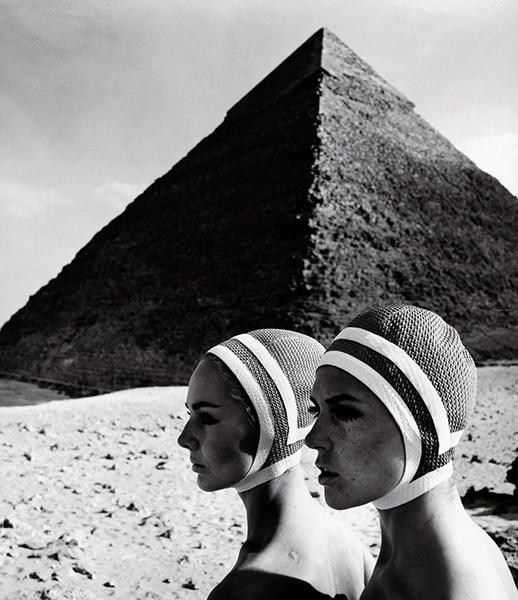
Photography and Egypt
By Maria Golia
Reaktion Books, 2009
Talk to just about anyone involved in the cultural practices of the Middle East, and the conversation inevitably turns to the dearth of documentation in and around the region. There are too few serious art historical studies. The catalogs of former galleries are not to be found; no one held onto the back issues of avant-garde magazines or experimental journals. Old-school critics never anthologized their work, and monographs for modern masters are too few and far between. The photographs are gone! The reasons are myriad and vary from place to place. Documents and archives have been destroyed by indifference as well as disasters natural and manmade, but the end result is the same: a whole lot of material is missing.
Maria Golia acknowledges this condition with bracing honesty at the outset of her new book, Photography and Egypt. “A comprehensive history of photography in Egypt would be a much heavier book than the one in the reader’s hands,” she writes in her introduction. That may sound like a preemptive apology, but it’s not. If anything, Photography and Egypt is an admonishment to those who threw away so many prints, plates, negatives, and more — and a challenge to those who might be inspired to go digging around in the trash.
In her epilogue, Golia offers several choice anecdotes. When she discovered that the Sociéte des amis de l’art in Cairo had organized a number of photography salons back in the 1930s, she sought out the organization’s current director — who was pleasantly surprised to learn of it. When she asked if he had any archives, he proudly shared with her the contents of a single desk drawer: a few catalogs from the 1960s, magazines put out by the Ministry of Culture in the 1980s, and a copy of an in-flight magazine produced by Saudi Arabian Airlines. When Golia visited Cairo University’s Faculty of Applied Arts, she learned that the department had just sold off all of its photographic equipment to a junk dealer. When she went to see the grandson of one of Egypt’s pioneering photographers, she heard that during a round of home renovations he had simply thrown several boxes of glass negatives, dating back to the 1900s, off his balcony.
So dire is the situation that it is amazing Golia pulled off this book at all. But despite its melancholy tone, Photography and Egypt is a treasure. Clocking in at just under two hundred pages and arranged into five sprightly chapters, the book begins with Ibn al-Haytham’s eleventh-century design of the camera obscura and courses through Maxime Du Camp’s Egyptian expeditions of the 1850s, the portrait studios of Alban and Armand, and the heyday of Van Leo, ending with the fourth iteration of the arts festival Photo Cairo. Golia is a terrific writer, and she brings to Photography and Egypt the same easygoing prose that made her earlier book, Cairo: City of Sand, such a pleasure to read. Like that book, Photography and Egypt thrives on Golia’s intense and unyielding affection for the place — an ardor that is balanced with wry humor and an occasionally brutal critique of the censorious nature of the current regime, the paranoia of life under emergency law, and the lethargy perpetuated by a swollen and ineffectual state bureaucracy.
Photography and Egypt is definitely not a history, comprehensive or otherwise. Neither does Golia emulate Susan Sontag by theorizing her subject. What she does is offer a brisk, cogent account of the political dimensions photography has taken on, from the times of Muhammad Ali through the reign of King Farouk, the rise and fall of the supremely photogenic Gamal Abdel Nasser, and the painfully awkward manner in which Anwar Sadat used photography to create a stilted image of himself. Golia carefully examines the interests that photography in Egypt has served, and she shifts with great dexterity from discussions of photography as Orientalist fantasy and hard-news reportage to discussions of photography as commercial product and fine art.
Clearly, Golia loves a good story and relishes the vintage. Perhaps the most fascinating excursion here is her consideration of photography’s place in Egyptian surrealism during the late 1930s. Who knew there was an André Breton–inspired group of artists, poets, and essayists called Art and Freedom, which penned a manifesto titled “Long Live Bad Art”; declared solidarity with the likes of Max Ernst and Paul Klee; translated Rimbaud’s “Season in Hell” into Arabic by way of pamphlets distributed freely in the streets; mounted exhibitions; and published art journals in three languages? According to Golia, the influence of Art and Freedom extended into painting and literature, but it no longer found expression in photography after the revolution in 1952. Photography and Egypt is full of tantalizing fragments like this, and Golia has thrown down a fine challenge for future researchers, giving them a pleasing tangle of threads to follow.